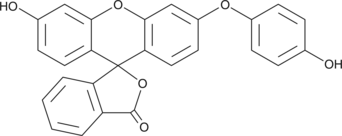Description
A cell-permeable aromatic amino-fluorescein derivative that can be oxidized and converted to fluorescein by ROS such as the hydroxyl radical, peroxynitrite, and ROS generated from a peroxidase/H2O2 system; ex/em = 490/515 nm
Formal name: (2-[6-(4′-hydroxy)phenoxy-3H-xanthene-3-on-9-yl]benzoic acid
Synonyms:
Molecular weight: 424.4
CAS: 359010-69-8
Purity: ≥98%
Formulation: A solution in methyl acetate
Application|Fluorescence||Product Type|Biochemicals|Labeling & Detection|Fluorescent Probes||Product Type|Biochemicals|Labeling & Detection|Reactive Probes||Research Area|Oxidative Stress & Reactive Species|Reactive Nitrogen||Research Area|Oxidative Stress & Reactive Species|Reactive Oxygen




